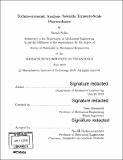| dc.contributor.advisor | Tonio Buonassisi. | en_US |
| dc.contributor.author | Sofia, Sarah E.(Sarah Elizabeth) | en_US |
| dc.contributor.other | Massachusetts Institute of Technology. Department of Mechanical Engineering. | en_US |
| dc.date.accessioned | 2019-09-16T21:16:23Z | |
| dc.date.available | 2019-09-16T21:16:23Z | |
| dc.date.copyright | 2019 | en_US |
| dc.date.issued | 2019 | en_US |
| dc.identifier.uri | https://hdl.handle.net/1721.1/122140 | |
| dc.description | Thesis: Ph. D., Massachusetts Institute of Technology, Department of Mechanical Engineering, 2019 | en_US |
| dc.description | Cataloged from PDF version of thesis. | en_US |
| dc.description | Includes bibliographical references (pages 131-141). | en_US |
| dc.description.abstract | There is an urgent need for rapid deployment of renewable-energy technologies to reduce anthropogenic carbon emissions and mitigate global climate change. Solar photovoltaics are essential for near-term decarbonization, but to achieve the terawatt scale deployment required, the technical and economic limitations of both Photovoltaic (PV) modules and systems must be addressed. Further solar panel manufacturing cost reductions and manufacturing scale-up are needed to increase the rate of adoption, as well as storage solutions to address the intermittency of solar at high adoption levels. This work uses technoeconomic analysis to examine the potential of tandem solar cell architecture to reduce the cost of solar, and what is required for solar-plus-storage systems to meet competitive levelized costs of electricity (LCOE) at high penetration. | en_US |
| dc.description.abstract | Tandems comprising one or more industrially mature PV materials, cadmium telluride (CdTe)-copper indium gallium selenide (CIGS), and perovskite-silicon tandems are explored using LCOE as a figure of merit and detailed energy yield analysis paired with manufacturing cost modeling. Through this, the optimal tandem architectures for different locations and applications are found. Significant potential for four-terminal tandems to be cost competitive in residential markets in the United States was demonstrated, while two-terminal tandems require significantly cheaper sub-cells costs. Additionally, the optimal path to designing cost-effective silicon-based tandems is shown, and a clear economic motivation for existing silicon manufacturers to invest in multicrystalline silicon tandems is outlined. To examine challenges of high-penetration PV, a solar-plus-storage model was developed and used to find target battery and storage costs required to reach competitive LCOEs at high penetrations. | en_US |
| dc.description.abstract | Flow batteries, a promising storage technology, were then modeled. These models show that current and near-term cost projections for both flow batteries and solar are still too high for cost effective solar-plus-storage systems at penetrations above 30%. Cost-performance trade-offs for flow batteries were then explored as potential paths for cost reduction. | en_US |
| dc.description.sponsorship | Support of Singapore Alliance for Research and Technology (SMART), the Martin Family Society for Fellows of Sustainability, and Quantum Energy and Sustainable Solar Technologies (QESST) | en_US |
| dc.description.statementofresponsibility | by Sarah Sofia. | en_US |
| dc.format.extent | 141 pages | en_US |
| dc.language.iso | eng | en_US |
| dc.publisher | Massachusetts Institute of Technology | en_US |
| dc.rights | MIT theses are protected by copyright. They may be viewed, downloaded, or printed from this source but further reproduction or distribution in any format is prohibited without written permission. | en_US |
| dc.rights.uri | http://dspace.mit.edu/handle/1721.1/7582 | en_US |
| dc.subject | Mechanical Engineering. | en_US |
| dc.title | Techno-economic analysis towards Terawatt-scale photovoltaics | en_US |
| dc.type | Thesis | en_US |
| dc.description.degree | Ph. D. | en_US |
| dc.contributor.department | Massachusetts Institute of Technology. Department of Mechanical Engineering | en_US |
| dc.identifier.oclc | 1117714030 | en_US |
| dc.description.collection | Ph.D. Massachusetts Institute of Technology, Department of Mechanical Engineering | en_US |
| dspace.imported | 2019-09-16T21:16:20Z | en_US |
| mit.thesis.degree | Doctoral | en_US |
| mit.thesis.department | MechE | en_US |
